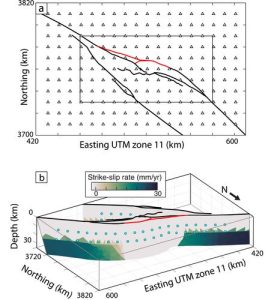Hanna Elston’s new paper “A New Method to Invert for Interseismic Deep Slip Along Closely Spaced Faults Using Surface Velocities and Subsurface Stressing-Rate Tensors” is out in Earth and Space Sciences

Hanna Elston’s new paper “A New Method to Invert for Interseismic Deep Slip Along Closely Spaced Faults Using Surface Velocities and Subsurface Stressing-Rate Tensors” is out in Earth and Space Sciences

Hanna Elston successfully defended her dissertation on Thursday December 7th. Investigating the impact of rheology and geometry on restraining bend evolution using analog and numerical models
She will start a post-doc with Jack Loveless in January. Congratulations Dr Elston!

One Wednesday December 6th, Christ successfully defended her MS thesis. Multi-method Approach to Assess the Impact of Off-fault Deformation During Fault Evolution
She will start a new job at Tetratek in San Diego, CA in January. Congratulations Christ!


Three research presenations from the UMass geomechanics group at the Geomod23 conference Paris, France Sept 25-28.

The National Academies of Science, Engineering and Medicine are hosting a 5 part workshop series on Disrupting Ableism and Advancing STEM. Michele is on the workshop planning committee, who have been working on this for the past 5 months. All sessions are recorded.
The first day was hybrid leadership summit with participants from all across the STEM ecosystem. On that day Michele moderated a panel on the”Describing Disability: Language and Models”
The following four workshops were entirely on-line and cover:

Wednesday March 1, Michele gave a talk to the Marine Geology and Geophysics (MGG) / Seismology, Geology and Tectonophysics (SGT) divisional seminar series.
What can tiny faults tell us about evolving seismic hazard of crustal strike-slip faults?
Evidence suggests that strike-slip fault systems become less complex as they mature and this evolving maturity can impact the occurrence of damaging earthquakes on the fault system. Inferring the past and future seismic potential of evolving faults depends on interpreting fault system evolution from present-day observations and conditions. How much could future slip rates differ from those of the recent past? How does off-fault deformation evolve with fault maturity? How does seismic potential change during fault system reorganization? Using scaled physical experiments we can directly measure variations in fault slip rate, off-fault deformation and seismic moment release rate associated with strike-slip fault evolution. We also use machine learning to train convolutional neural networks to predict off-fault deformation from active strike-slip fault maps. These findings can guide our interpretations of past and future seismic hazards from present-day crustal conditions.